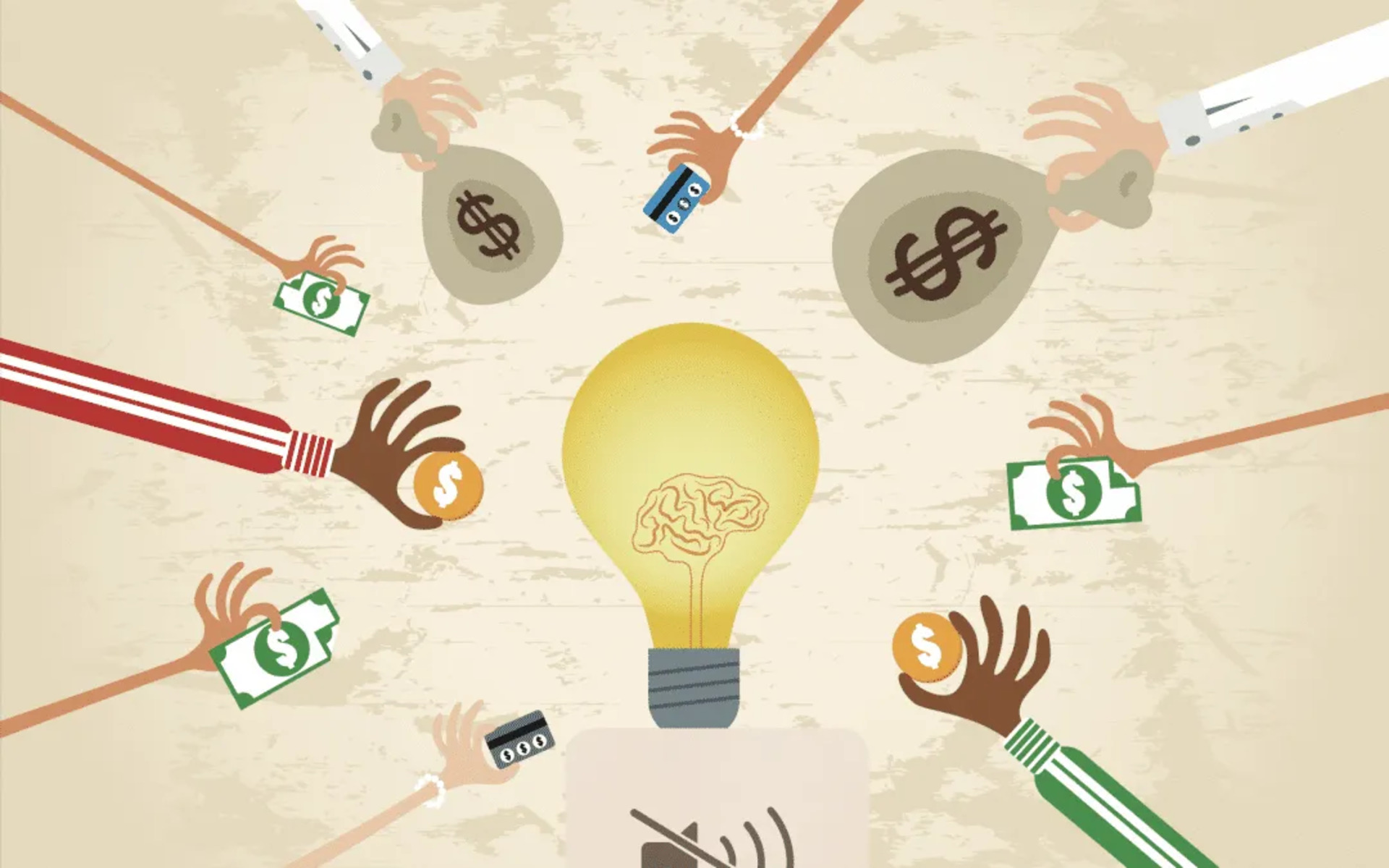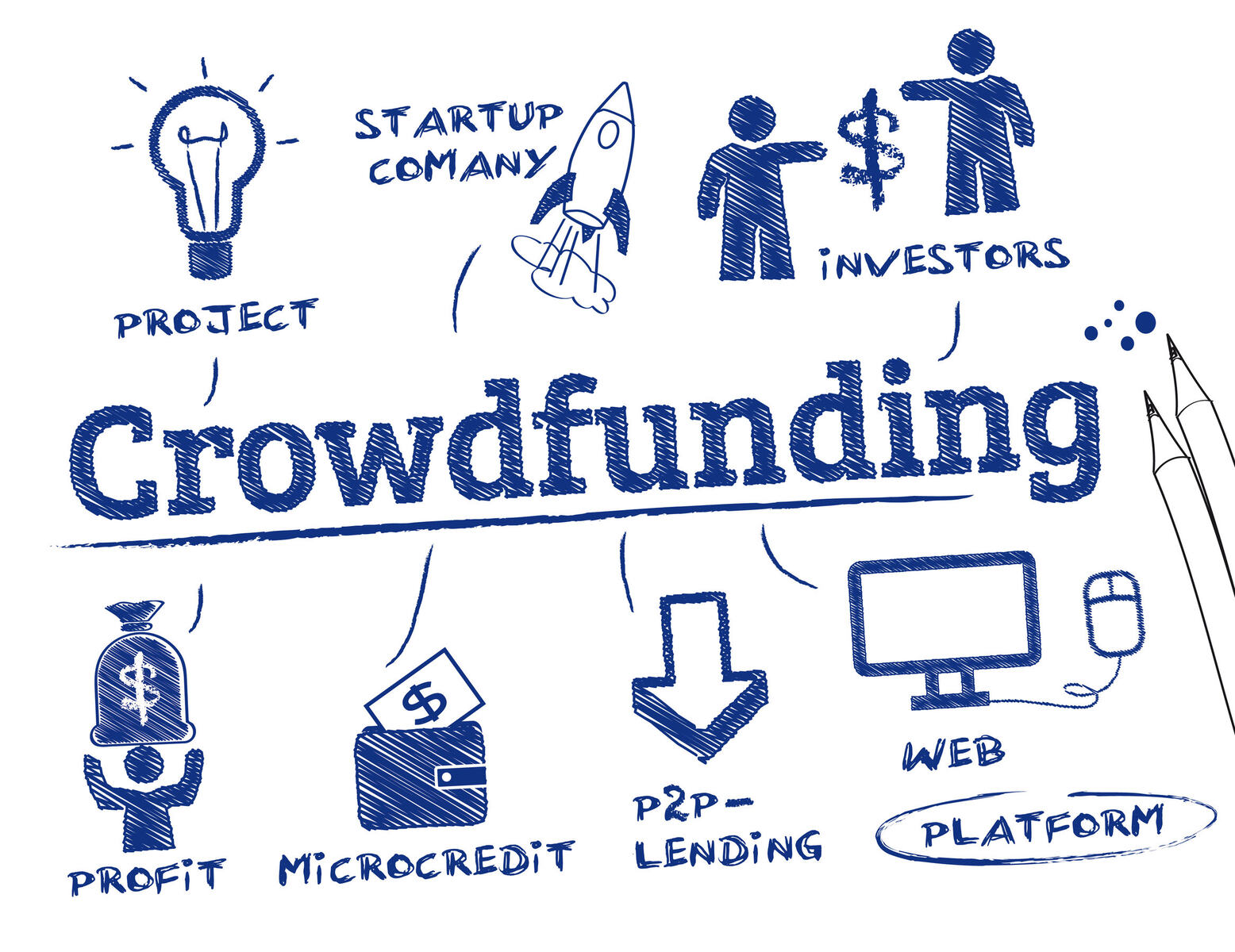Introduction
Welcome to the exciting world of crowdfunding! In recent years, crowdfunding has revolutionized the way innovative projects, businesses, and individuals raise funds for their ventures. This alternative financing method has gained popularity and widespread use across various industries, empowering entrepreneurs, artists, and philanthropists to bring their dreams to life.
But what exactly is crowdfunding? Simply put, it is a collective effort of individuals or organizations who pool their financial resources to support a specific project or cause. It allows passionate individuals to connect with a wider audience and gather funding from many small contributors instead of relying on a single source of capital.
So, how does crowdfunding work? Well, it typically begins with a person or group creating a campaign on a crowdfunding platform. They outline their goals, explain the purpose of the project, and set a target amount to be raised within a specified timeframe. The campaign is then shared through social media, emails, and other channels to attract potential backers.
There are different types of crowdfunding platforms available, each with its own unique features and focus. For instance:
- Reward-based crowdfunding: This type of crowdfunding offers backers a non-financial incentive, such as a product, service, or experience, in exchange for their contribution.
- Equity crowdfunding: With equity crowdfunding, individuals invest their funds in exchange for equity or ownership in the project or business.
- Donation-based crowdfunding: In this form, contributors support a cause or project without expecting any financial return.
- Lending-based crowdfunding: Also known as peer-to-peer lending, this model allows individuals to lend money to others and receive repayment with interest over time.
What is crowdfunding?
Crowdfunding is a revolutionary financing model that enables individuals, businesses, and organizations to raise funds for their projects, ventures, or causes by gathering small contributions from a large number of people. It harnesses the power of the crowd, allowing passionate supporters to come together and make a collective impact.
Traditionally, obtaining funding for a new business, creative project, or charitable endeavor often involved seeking investment from a single source or relying on personal savings. However, crowdfunding has disrupted this conventional approach by providing a platform for individuals to showcase their ideas and connect with a broader audience who are willing to support and invest in their vision.
One of the key aspects of crowdfunding is the centralized online platform that facilitates the entire process. These platforms act as intermediaries between the project creators and potential backers, providing a space where creators can showcase their projects and backers can discover and contribute to the initiatives they are passionate about.
Crowdfunding campaigns typically involve the following key elements:
- Project description: Creators outline their project or initiative, explaining its purpose, goals, and target audience. They provide details about the project and its potential impact to engage and attract potential backers.
- Fundraising goal: Campaign creators set a specific monetary target that they aim to reach within a predetermined timeframe. This goal serves as a benchmark for measuring the campaign’s success and helps backers understand what the funds will be used for.
- Rewards or incentives: In reward-based crowdfunding, creators offer backers various non-financial incentives. These can range from early access to the product or service being developed to exclusive experiences or limited edition merchandise. These rewards act as a way to motivate and thank contributors for their support.
- Marketing and promotion: To ensure the success of a crowdfunding campaign, creators must actively promote their project through various channels such as social media, email marketing, and personal networks. By effectively communicating the value of their project and engaging with potential backers, creators can increase the likelihood of reaching their funding goal.
- Backer engagement: Throughout the campaign, creators interact with their backers, providing updates, answering questions, and expressing gratitude for their support. This engagement helps foster a sense of community and connection, making backers feel involved and valued.
In summary, crowdfunding is a dynamic and inclusive funding model that allows individuals and organizations to bring their ideas to life by harnessing the collective support of a diverse community. It opens doors to new opportunities, democratizes access to capital, and empowers individuals to turn their visions into reality.
How does crowdfunding work?
Crowdfunding operates on a simple principle: multiple individuals contribute small amounts of money to fund a specific project or cause. This collective effort reduces the reliance on traditional sources of funding, such as banks or venture capitalists, and allows project creators to tap into a wider network of potential supporters.
The process of crowdfunding generally follows these steps:
- Project creation: The creator of a project or campaign defines their idea, sets a fundraising goal, and outlines the purpose and impact of their endeavor. They carefully craft a compelling story that engages potential backers and showcases the unique aspects of their project.
- Crowdfunding platform selection: The project creator chooses a crowdfunding platform that aligns with the type of campaign they want to launch. There are numerous platforms available, each catering to specific crowdfunding models such as reward-based, equity-based, donation-based, or lending-based.
- Campaign promotion: Once the project is live on the chosen crowdfunding platform, the creator initiates a comprehensive marketing and promotion strategy. They leverage their existing networks, social media channels, and other marketing tactics to spread the word about their campaign. Effective communication and engagement with potential backers are crucial during this stage.
- Backer contributions: Interested individuals who resonate with the project’s vision and goals visit the crowdfunding platform, review the project details, and make a contribution. The platform facilitates secure transactions for backers to pledge their financial support.
- Progress updates: To keep backers informed and engaged, creators regularly provide updates on the project’s progress. They share milestones, achievements, and any challenges encountered along the way. Clear and transparent communication builds trust and maintains the interest of backers throughout the fundraising journey.
- Campaign completion: Once the campaign duration or fundraising goal is reached, the project enters its final phase. The collected funds are typically transferred to the project creator, and they proceed with executing their proposed plan, whether it’s launching a product, realizing a creative endeavor, or implementing a social initiative.
- Rewards or returns: In reward-based crowdfunding, project creators fulfill their promises to backers by delivering the agreed-upon rewards or incentives. In equity-based crowdfunding, investors may receive a financial return if the project achieves success and generates profits. The nature of rewards or returns depends on the specific crowdfunding model adopted.
Crowdfunding operates on a global scale, reaching a diverse pool of potential backers who are passionate about supporting innovative projects, social causes, and entrepreneurial ventures. It offers a democratic approach to fundraising, empowering creators to showcase their ideas, build communities around their projects, and secure the resources needed to turn their dreams into reality.
Different types of crowdfunding platforms
The rise of crowdfunding has led to the emergence of various platform options that cater to different types of crowdfunding campaigns. Each platform specializes in a specific crowdfunding model, offering unique features and benefits to both project creators and backers. Let’s explore the different types of crowdfunding platforms:
- Reward-based crowdfunding platforms: These platforms are the most common type and allow creators to offer non-financial incentives or rewards to backers in exchange for their contributions. Backers can choose a contribution level that corresponds to a specific reward, such as early access to a product, personalized merchandise, or exclusive experiences related to the project.
- Equity crowdfunding platforms: Equity crowdfunding platforms are designed for businesses and startups seeking investment in exchange for equity in their company. Investors can contribute funds and become shareholders, earning potential financial returns if the business succeeds. These platforms are regulated and often require companies to meet certain criteria before their campaigns are approved.
- Donation-based crowdfunding platforms: Donation-based platforms focus on charitable causes, allowing individuals and nonprofit organizations to raise funds for social initiatives, medical expenses, disaster relief, and more. Backers contribute without expecting any financial returns but are driven by a desire to support a cause they believe in.
- Lending-based crowdfunding platforms: Lending-based platforms, also known as peer-to-peer lending platforms, connect individuals or businesses seeking loans with potential lenders. Backers provide funds that are paid back with interest over a specified period. These platforms offer an alternative to traditional banking institutions and provide borrowers with access to capital and lenders with attractive investment opportunities.
When choosing a crowdfunding platform, creators should consider several factors. These include:
- Fees: Platforms charge various fees, including a percentage of funds raised, transaction fees, and processing fees. Creators should carefully review the fee structure to ensure it aligns with their budget and fundraising goals.
- Reach and audience: Different platforms have varying levels of reach and audience engagement. Creators should assess how well the platform attracts potential backers who may have an interest in their specific project or cause.
- Platform reputation: Researching and evaluating the platform’s reputation, user reviews, and success stories can help creators gauge the platform’s credibility and track record.
- Platform features: Each platform offers different features, such as campaign management tools, analytics, and social sharing capabilities. Creators should assess which features are important for effectively managing and promoting their campaign.
- Regulations: Depending on the type of campaign, creators should ensure that the chosen platform complies with relevant regulatory requirements. This is particularly important for equity-based crowdfunding, which is subject to specific securities regulations in many countries.
Choosing the right crowdfunding platform is essential for the success of a campaign. Understanding the different types of platforms available and carefully evaluating their features and suitability for the project can significantly impact the outcome of a crowdfunding campaign.
Factors that influence the amount raised
When it comes to crowdfunding, the amount raised can vary greatly from one campaign to another. The success of a crowdfunding campaign depends on a variety of factors that can influence the overall funding achieved. It’s important for project creators to understand these factors in order to maximize their chances of reaching their fundraising goals. Here are some key factors that can influence the amount raised in a crowdfunding campaign:
- Project viability and uniqueness: The nature and uniqueness of the project are crucial. Backers are more likely to support projects that stand out, have a clear value proposition, and offer something innovative or different from what already exists in the market.
- Effective storytelling: A compelling and well-crafted story that effectively communicates the project’s purpose, goals, and impact can captivate potential backers. It’s important to showcase the passion and motivation behind the project and connect it to the emotions and values of the target audience.
- Clear and realistic funding goals: Setting a reasonable funding goal is crucial. Backers are more likely to support projects with attainable goals and a transparent breakdown of how the funds will be used. Unrealistic funding goals can deter potential backers and make the project seem less credible.
- Engaging marketing and promotion: A strong marketing and promotion strategy is essential to attract attention to the campaign. Utilizing various channels, such as social media, email marketing, and online communities, can help broaden the campaign’s reach and engage with potential backers.
- Reward offerings: In reward-based crowdfunding, the attractiveness and relevance of the rewards offered to backers can significantly impact the amount raised. Offering unique and desirable rewards that align with the project can incentivize backers to contribute at higher levels.
- Early momentum: Generating early traction and momentum in a campaign is crucial. It can create a sense of urgency and social proof that encourages more people to back the project. Successfully engaging early backers and leveraging their support to attract more contributors can significantly boost the amount raised.
- Backer engagement and communication: Consistent and transparent communication with backers throughout the campaign is vital. Regular updates, prompt responses to questions and feedback, and a genuine connection with backers help foster a sense of trust and community. This, in turn, encourages continued support and potential referrals.
- Targeted audience and network: Identifying and targeting the right audience for the project is key. Understanding the demographics, interests, and behaviors of the target audience can help creators tailor their marketing efforts and connect with the most relevant potential backers. Leveraging personal networks and engaging existing supporters can also play a significant role in driving contributions.
- Timing and external factors: External factors, such as seasonal trends, current events, or market conditions, can impact the success of a crowdfunding campaign. Researching and considering these factors can help project creators choose the optimal time to launch their campaign and maximize exposure.
While these factors can significantly influence the amount raised in a crowdfunding campaign, it’s important to note that each project and situation is unique. Project creators should carefully analyze their specific context and adapt their strategies accordingly to enhance their chances of achieving their funding goals.
Average amount raised in reward-based crowdfunding campaigns
Reward-based crowdfunding is one of the most popular forms of crowdfunding, allowing project creators to offer non-financial incentives or rewards to backers in exchange for their contributions. The amount raised in reward-based crowdfunding can vary significantly depending on various factors, such as the nature of the project, the creator’s marketing efforts, and the appeal of the rewards offered. While there is no one-size-fits-all answer to the average amount raised in reward-based crowdfunding campaigns, examining industry trends can provide valuable insights.
According to Kickstarter, one of the leading reward-based crowdfunding platforms, the average amount raised per successfu- funded project is around $25,000. However, it’s important to note that this average can vary widely depending on the project category and the campaign’s unique circumstances. Certain categories, such as technology, design, and games, tend to raise higher amounts, while others, like crafts or publishing, may have lower average funding goals.
Factors that can influence the amount raised in reward-based crowdfunding campaigns include the project’s level of innovation, its potential for addressing a market need, and the creator’s ability to effectively communicate the project’s value. Additionally, the strength of the creator’s network and their marketing efforts play a significant role in attracting backers and generating momentum for the campaign.
Another factor to consider is the reward structure. Projects that offer a range of attractive and relevant rewards tend to attract more backers and raise higher amounts. The rewards should be enticing enough to prompt potential backers to contribute at higher levels. Some creators offer tiered reward levels, allowing backers to choose their contribution amount and corresponding reward.
It’s worth noting that reward-based crowdfunding campaigns often follow a “U-shaped” funding pattern, where the majority of contributions come in during the early days and the final days of the campaign. This pattern highlights the importance of generating early momentum and maintaining campaign engagement until the very end.
While examining the average amount raised in reward-based crowdfunding campaigns can provide insights, it’s essential for project creators to focus on creating an engaging campaign, delivering on their promises, and fostering a strong connection with their backers. By striving for excellence in these areas, creators can improve their chances of surpassing the average and achieving their desired funding goals.
Average amount raised in equity crowdfunding campaigns
Equity crowdfunding has emerged as an alternative financing model that allows businesses and startups to raise investment capital from a crowd of individual investors in exchange for equity or ownership in their company. The amount raised in equity crowdfunding campaigns can vary significantly based on factors such as the industry, stage of the company, and the attractiveness of the investment opportunity. While there is no definitive average amount raised in equity crowdfunding campaigns, it’s important to explore industry trends and patterns to gain insights.
The average amount raised in equity crowdfunding campaigns is influenced by several factors, including the company’s valuation, the percentage of equity offered, the size of the investment rounds, and the level of interest from potential investors. Companies with strong growth potential, a compelling business model, and an innovative product or service tend to attract more investor interest and raise larger amounts.
According to data from various equity crowdfunding platforms, the average amount raised by companies ranges from tens of thousands to millions of dollars. The specific amount depends on the industry and the goals of the company. For example, technology startups often raise higher amounts due to the scalability and potential for significant returns in the technology sector.
It’s worth noting that the amounts raised in equity crowdfunding campaigns can be influenced by external factors such as market conditions, investor sentiment, and the overall state of the economy. During a favorable investment climate, companies may have an easier time attracting larger investments, resulting in higher average amounts raised.
Other factors that contribute to the success of equity crowdfunding campaigns include the strength of the company’s business plan, the credibility and reputation of the management team, and the ability to effectively communicate the investment opportunity to potential investors.
Equity crowdfunding campaigns typically have a minimum funding target and a maximum funding cap. While the exact amounts can vary, they are often designed to ensure that the company can receive sufficient investment while maintaining a reasonable dilution of equity.
It’s important to remember that the success of an equity crowdfunding campaign goes beyond just raising a certain amount of money. Companies should focus on attracting the right investors who can provide not only capital but also expertise, networks, and other strategic benefits that can contribute to the company’s long-term growth and success.
In summary, the average amount raised in equity crowdfunding campaigns varies widely and is influenced by numerous factors. Companies should thoroughly prepare their campaigns, present compelling investment opportunities, and engage potential investors to maximize their funding potential.
Average amount raised in donation-based crowdfunding campaigns
Donation-based crowdfunding provides a platform for individuals and organizations to raise funds for charitable causes, personal needs, or community projects. Unlike other forms of crowdfunding, donation-based campaigns focus on collecting contributions without offering financial returns or tangible rewards to donors. The amount raised in donation-based crowdfunding campaigns can vary significantly based on factors such as the cause’s appeal, the campaign’s reach, and the generosity of the donors.
It’s important to note that the average amount raised in donation-based crowdfunding campaigns can differ widely depending on the nature of the cause or project. Popular causes, such as disaster relief efforts or campaigns addressing critical social issues, typically attract larger contributions and raise higher amounts. However, smaller, localized projects or personal fundraising causes may have more modest funding goals and therefore raise less.
According to various donation-based crowdfunding platforms, the average amount raised per campaign can range from a few hundred dollars to tens of thousands of dollars. The exact amount depends on various factors, including the campaign’s duration, the effectiveness of the campaign’s storytelling and messaging, and the level of engagement and support from the donors’ networks.
Campaign creators can optimize the amount raised by considering several key strategies:
- Compelling storytelling: Sharing a personal and impactful story that resonates with potential donors can encourage them to contribute. Creating an emotional connection and illustrating the urgency and importance of the cause can inspire larger donations.
- Engaging visuals and media: Utilizing compelling visuals such as photos, videos, and infographics can help convey the project’s purpose and impact. Visual content can make the donation experience more immersive, resulting in increased engagement and donations.
- Utilizing social media and online networks: Leveraging social media platforms and personal networks can significantly expand the reach of a donation-based campaign. Sharing the campaign across various channels and encouraging friends, family, and supporters to amplify the message can drive more donations.
- Establishing credibility and trust: Building trust with potential donors is crucial. Transparency about how the funds will be used and providing regular updates on the campaign’s progress can help establish credibility and encourage continued support.
- Engaging and acknowledging donors: Acknowledging and expressing gratitude to donors is essential. Promptly and personally thanking donors, sharing updates on the impact of their contributions, and involving them in the project’s journey can foster a sense of involvement and encourage further donations.
While the average amount raised in donation-based crowdfunding campaigns can vary, campaigns that effectively leverage storytelling, engage supporters, and create a strong connection with the cause have a greater chance of meeting and even exceeding their funding goals.
Average amount raised in lending-based crowdfunding campaigns
Lending-based crowdfunding, also known as peer-to-peer lending or debt-based crowdfunding, allows individuals or businesses to borrow funds from a community of lenders. In lending-based crowdfunding campaigns, borrowers apply for loans and propose interest rates, terms, and repayment plans. The amount raised in lending-based crowdfunding campaigns can vary depending on factors such as the loan purpose, borrower’s creditworthiness, and the attractiveness of the investment opportunity for lenders.
The average amount raised in lending-based crowdfunding campaigns ranges widely, as it depends on factors such as the borrower’s financial credibility, the loan amount requested, and the terms of the loan. Some borrowers may seek smaller loans, while others may require significant amounts for business expansion, debt consolidation, or other purposes.
On lending-based crowdfunding platforms, borrowers have the opportunity to pitch their loan request to individual lenders who can then choose to fund a portion or the full loan amount. The average loan amount varies across platforms and can range from a few thousand dollars to hundreds of thousands of dollars.
It’s important to note that the amount raised in lending-based crowdfunding campaigns is influenced by various factors, including:
- Borrower’s creditworthiness: The creditworthiness of the borrower plays a significant role in the amount raised. Borrowers with a strong credit history and higher credit scores are often able to secure larger loan amounts and attract more lenders.
- Interest rates: The interest rate proposed by the borrower can impact the attractiveness of the loan to lenders. Competitive interest rates can attract more lenders and increase the likelihood of raising a higher amount.
- Loan purpose: The purpose of the loan can influence lender interest. Loans for business expansion, investments with measurable returns, or projects with a social impact may have a higher chance of attracting lenders and raising larger amounts.
- Repayment terms: Borrowers who propose favorable repayment terms, such as a manageable repayment period and consistent cash flow projections, may find it easier to secure larger loan amounts.
- Lender network and lenders’ investment preferences: The size and diversity of the lender network on a lending-based crowdfunding platform can impact the loan amount raised. Borrowers who align with the investment preferences of a larger pool of lenders may increase their chances of raising higher amounts.
It’s important for borrowers to present a compelling loan application that conveys their financial strength, purpose of the loan, and ability to repay. Lenders consider information provided by borrowers when deciding to fund a loan, and a clear and well-structured loan proposal can increase the chances of a successful campaign.
While there is no specific average amount raised in lending-based crowdfunding campaigns, borrowers with a solid financial profile, a well-defined loan purpose, and an attractive interest rate have a better chance of raising the desired loan amount from individual lenders.
Tips to increase the amount raised in your crowdfunding campaign
Running a successful crowdfunding campaign requires a strategic approach to attract and engage potential backers. Here are some tips to help you increase the amount raised in your crowdfunding campaign:
- Create a compelling story: Craft a compelling narrative that connects with potential backers on an emotional level. Clearly communicate the purpose, goals, and impact of your project in a way that resonates with your target audience.
- Set realistic funding goals: Set a funding goal that is attainable and aligned with the scope of your project. Unreasonable goals may deter potential backers, while achievable goals can build momentum and motivate individuals to contribute.
- Offer desirable and relevant rewards: In reward-based crowdfunding, create rewards that are attractive and aligned with your project. Think creatively to offer unique incentives that will motivate backers to contribute at higher levels.
- Invest in high-quality visuals and media: Use high-quality images, videos, and graphics to visually showcase your project and engage potential backers. Compelling visual content can be highly effective in capturing attention and conveying your message.
- Build a strong online presence: Increase your campaign’s visibility through active participation on social media platforms, blogs, and relevant online communities. Engage with potential backers, share updates, and leverage your network to spread the word about your campaign.
- Engage with your backers: Establish a regular communication plan to keep your backers informed and engaged throughout the campaign. Provide updates on the project’s progress and express gratitude for their support. Encourage backers to become advocates and share your campaign with their own networks.
- Personalize your outreach: Create personalized messages and reach out individually to potential backers who may have a specific interest in your project. Tailoring your approach can help you establish meaningful connections and increase the likelihood of support.
- Collaborate with influencers: Collaborate with influencers or individuals who have a strong following and an interest in your project’s niche. Their endorsement and support can significantly increase the reach and credibility of your campaign.
- Hold events or promotions: Organize events or promotions that complement your campaign and help generate excitement. These can include product demos, giveaways, or exclusive offers for backers.
- Express gratitude and show appreciation: Show genuine appreciation for your backers and express gratitude for their support. Send personalized thank-you messages and consider offering post-campaign perks or opportunities exclusively for your backers.
Remember, running a successful crowdfunding campaign requires dedication, persistence, and effective communication. By implementing these tips and tailoring your strategy to fit your unique project, you can increase the amount raised and maximize the success of your crowdfunding campaign.
Conclusion
Crowdfunding has revolutionized the way individuals, businesses, and organizations raise funds for their projects, ventures, and causes. Whether it’s reward-based, equity-based, donation-based, or lending-based crowdfunding, each model offers a unique approach to funding and provides opportunities for success.
Understanding the average amounts raised in different types of crowdfunding campaigns can provide valuable insights and benchmarks, but it’s important to remember that success is not solely determined by these averages. Factors such as the project’s viability, effective storytelling, targeted marketing, and engagement with backers significantly impact the overall amount raised.
To increase the amount raised in a crowdfunding campaign, project creators should focus on crafting a compelling story, setting realistic funding goals, offering desirable rewards, and leveraging effective marketing strategies. Engaging with potential backers, building a strong online presence, and personalizing outreach efforts are also critical to attracting support and driving contributions.
It’s important to note that crowdfunding is not just about the funds raised but also about building a community of supporters, creating connections, and validating the project or cause. Throughout the crowdfunding journey, maintaining open communication, expressing gratitude, and delivering on promises are crucial for building trust and cultivating long-term relationships with backers.
While crowdfunding offers tremendous opportunities, it requires dedication, effort, and adaptability. Project creators should continuously refine their strategies, learn from both successes and challenges, and remain flexible in adjusting their approach to optimize the chances of raising the desired amount.
In the ever-evolving landscape of crowdfunding, staying informed about industry trends, learning from best practices, and utilizing the available resources and platforms will further enhance the chances of crowdfunding success. By combining passion, creativity, and effective execution, project creators can maximize the potential of crowdfunding and bring their visions to life.

























